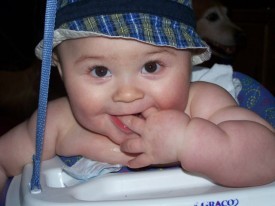
In my August post, I discussed how the primary job of the infant brain is to detect relevant information about language and the environment in which the baby is born and to design itself, in a relatively short period of time, to be an expert at that language and environment. This month, we will continue the discussion of how the brain developsin a young infant.
The genes more or less provide the blueprint for the brain’s hardware and early wiring, but after a child is born, and perhaps even for several months before, the stimulation in the world around the infant sets up the experiences that the brain uses to wire itself for later learning. Whether that stimulation is beneficial or detrimental is a matter of expectations: if our goal is that a child be good at attending to brief segments of information (so called, “sound bites”) but not be as good at sustaining attentionfor a longer period of time (as might be expected in a first grade classroom), then hours of watching television might be viewed as beneficial. But since teachers do not talk in “sound bites,” and most education, from learning to read to learning algebra, requires extended periods of concentration to relatively unchanging stimulation (a teacher’s lengthy explanations, for example), television watching may prepare the brain for attentional skills that are not beneficial for school success.
Parents can help their babies and young children prepare for the “listening” demands of school by spending time in activities where Mom or Dad talk, read or sing to their child in a quiet setting for fifteen minutes to half an hour (for children over three) at a time. Even infants under six months of age can be encouraged to “listen” to adults. Young infants are very interested in facial expression and voice melody but they need to see a parent’s face and hear their voice together to build up the brain networks that sustain their attention to speech. Mom or Dad can build this network by holding the baby within a foot of their face (lying on a parent’s lap or being held close a parent can talk to the baby about parts of his face for example, “You have such a nice nose, here is your nose, look at Mommy’s nose; and here is your ear and this is Mommy’s ear.” As the baby gets older and can sit up, Dad and Mom can begin to pay games that further attract the baby’s attention to their voice and face, like “Peek-a-Boo.” Babies under a year often enjoy these activities and can attend for several minutes at a time, preparing their brain for later attention to speech.
For children over a year, parents can establish a routine “quiet time” to settle a child down before bedtime. A fifteen minute to half-hour quiet time where Mom or Dad sit with the child on their bed and look at books together, or talk about something special that happened during the day, or sing nursery songs before bed can provide a perfect opportunity build listening skills. If a child gets accustomed to sitting for 30 minutes listening to songs or stories he will have he will have established the attention skills that he will need when he gets to school.
As a case in point, the American Pediatric Association has recently published research indicating that too much exposure to television during the first two years of life seems to increase the likelihood that the child will be diagnosed with Attention Deficit Disorder in the early school years. 1From a neuroscientists’ perspective, attention deficit disorder may not represent so much an abnormal brain as a brain that has developed in a way that is not well suited to sitting and learning in a classroom environment.
That does not necessarily imply the child is not “intelligent” (although parents may be led to view the child that way) or that the child is not “well behaved’, but it does bias the child against being viewed as intelligentand well behaved in an environment that places emphasis on “sitting still and listening”, namely the typical public school classroom. And although one option might be for parents to remove the child with a “short attention span” from the public school environment and either home school the child or pay for a private school that is not as overtly punitive, ultimately, the child will most likely eventually have to sit and concentrate for long periods of time, either at college, or at work. So, it would make sense to build the child’s brain in such a way to allow him or her to successfully competein a world where listening or watching and concentration to one task are important.
That does not mean, however, that the brain is inflexible, unable to multitask, or incapable of handling rapidly changing information as well. Think of a professional basketball player, who has developed a genius of sorts for a sport, who must maintain concentration on his or her team position as well as an expected play while at the same time following the ball and observing opponents and team members as they move around the floor. So, it turns out, a brain that is good at sustained attention to a single task can also be good at multitasking as well as handling rapidly changing information.
The human brain appears to be remarkably equipped to develop these capacities and to utilize them in almost all aspects of learning in which one might find himself, be it a classroom, a sports arena, a symphony orchestra, or a multitude of other performance. 2The key is preparing the brain for these potential capacities during the first few years of life.
[1]Journal of the American Pediatric Association, 2007
[2]Merzenich, M. Personal communication, 2008

